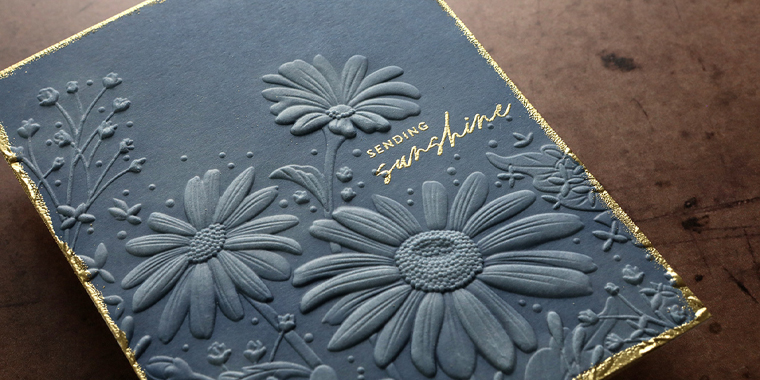March 05, 2025

There lies a sophisticated finishing technique that brings an alluring dimension to the world of design and printing. This technique is known as embossing. It adds a touch of elegance, sophistication, and texture to printed boxes. In addition, it turns the packaging into tangible works of art.
Embossed designs also transform plain surfaces into tactile wonders. In this blog post, we will explore the enchanting allure of embossing. We will also unravel its techniques, applications, and the transformative impact it has on an array of print projects.
The process of creating a raised image, design, or text is called embossing. It is done on different types of materials like paper, leather, or metal sheets. It can also be found on cards, stamps, paper cups, leather notebooks, packaging boxes, etc. Moreover, it is also a popular technique in DIY crafts and activities.
The tactile effects of embossing are captivating. As people glide their fingers on the textured surface they feel a unique sensory dimension. In addition, visually, it creates shadows and highlights. They also enhance the design's aesthetics and make it pop off the page. Finally, the play of light and shadow gives depth and character to the embossed elements.
Embossing offers plenty of approaches to enhance printed materials. There are three main types of embossing.
It creates raised designs without adding ink or foil. Here, the pressure is applied by the embossing die. Blind embossing is suitable for designs that demand a tactile quality without the use of color or shine. Furthermore, the raised areas are the same color as the embossed paper or material, creating a subtle, monochromatic contrast.
This technique combines Embossing with ink or foil stamping. The embossing process is followed by the printing of the design. It creates raised designs that align precisely with the printed portions. In addition, ink or foil highlights the design. This technique is ideal when you want to emphasize specific elements within a design. For instance, in business cards or invitations.
This involves multiple raised levels within a design. In this, different portions of the design have embossed designs at varying depths to add a dimensional quality. Moreover, it produces a visually dynamic effect with variations in height and depth.
Embossing adds a touch of depth and elegance to various products. These include embossed leather, embossed stickers, business cards with embossing, embossed rolling pins, embossed stationery, embossed fabric, embossed wedding invitations, embossed stamps, and embossed paper.
Moreover, embossed labels on products enhance brand recognition and convey a premium quality image. For example, an image of a wine bottle label with an embossed logo and vineyard details makes it more visible on the store shelves.
The embossed designs offer a range of advantages such as:
Despite many advantages, certain factors limit the application of embossing such as:
Read Also: Differences & Benefits Explained By Embossing vs Debossing
Even, you can do paper embossing easily in homes with the use of certain materials. Here are the embossing tools you would require.
Use these embossing tools follow these simple steps and make your embossed design. Boast your creativity in front of your family and friends.
Read: How Debossing Is The Key To Premium Branding?
To conclude, embossing is the most functional innovation in the field of finishing materials. It has changed the flat surfaces into a work of 3D art. Now the normal-looking packaging, cards, and stickers have an additional touch of sensation. Customers can glide their fingers on the packaging and get a more enhanced experience. Moreover, they feel a sense of royalty when their products have embossed designs.
So, if you are looking to add a sense of sophistication and luxury to common printing, consider adding embossed designs to it. You can contact Custom Designs Boxes to apply embossing on your Custom Boxes. We also provide top-notch printing and packaging services to all our beloved customers.
Find the perfect packaging solutions tailored to your industry niche.
Don't just imagine – experience excellence up close, as you can check our superior craftsmanship before making your decision by ordering your sample kit.
